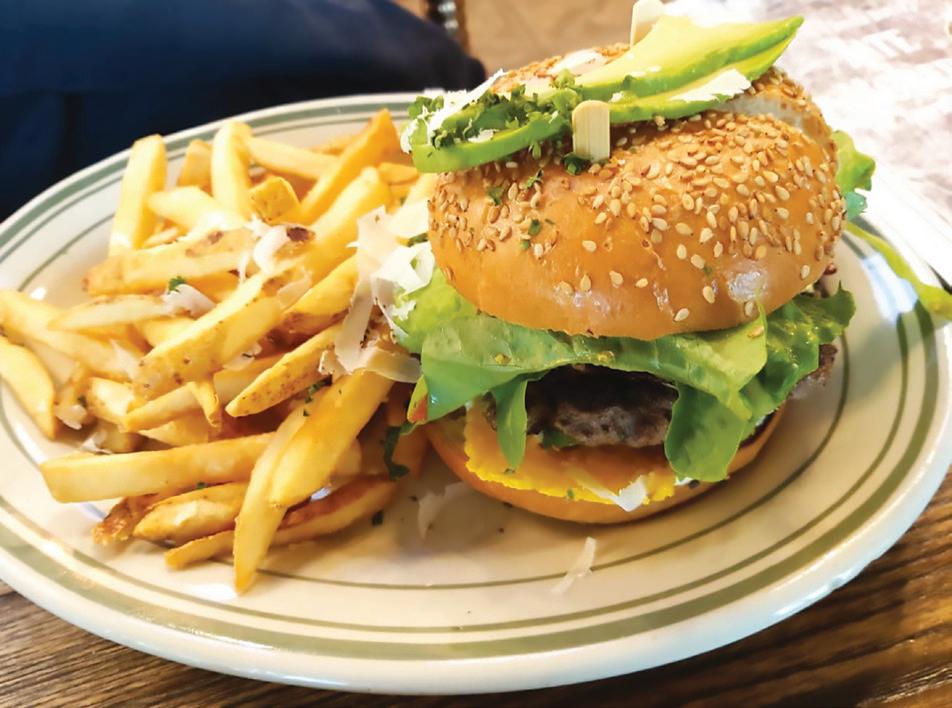
9 minute read
Restaurant Review: Tate Modern

Tate Modern
Advertisement
Fancy Dining in Sangmu

Reviewed by Melline Galani
Gwangju is well known for its fancy restaurants, pubs, coff ee houses, and nightlife. Located in the Sangmu area, near the Kim Daejung Convention Center, Tate Modern has been present for about two years. Before the COVID-19 era, eating there without a reservation would have been impossible – unless you wanted to wait for a couple of hours. I have visited the place before and during the pandemic, and the food and atmosphere were the same – only the crowdedness has diminished.
Looking more like a chic warehouse on the outside, Tate Modern is a Western-style coff eeshop and restaurant with a generous interior decorated in a simple stylish manner. It reminds me somehow of some European restaurants, except for the generous parking outside. Th e interior is divided into two spaces (though mainly by the way they are decorated) with a café-style area on one side and dinning on the other. Th e café space is also used as a waiting hall if the dinning area is packed, and you are most welcome to order a delicious drink while waiting. Th e fusion dishes are tasty and interesting with fresh ingredients grown locally. Th e food is delicious, and the prices refl ect the taste. Tate Modern is not a place where you would go just because you want to grab something to satisfy your hunger. It is a place of relaxation over a glass of wine accompanied by a steak, salad, or parfait shared with your best friend, a meeting with colleagues, or a perfect date. Th ey serve a wide range of coff ee, beverages, wines, desserts, salads, steaks, hamburgers, and the soup of the day.
Th e last time I was there, I ordered a homemade doublecheese gourmet burger, a steak, and the potato cheese soup of the day, all accompanied by a cappuccino and a hot chocolate. Th e steak was a generous 280 grams with assorted grilled vegetables and a delicious mustard sauce that was more than enough for one person. You may choose the temperature you want the steak to be done at – our style is well-done. Th e price for the steak is 42,000 won. Th e 14,800 won that you pay for the burger is worth every penny. Not only is it a generous portion but the taste is great. Filled with avocado, fresh vegetables, and cheese, it has a juicy taste complemented by the crispy french fries. I am not particularly a fan of burgers, but
this one was really good. Th ere are two types of soup of the day: potato cheese cream soup, served on Tuesdays, Wednesdays, Fridays, and Saturdays, and mushroom cream soup, served on the other days. For 4,800 won you get a hot, creamy delicious
On a previous visit, I also tried the farmhouse salads and pastas, which come in large sizes, in my opinion. I just love salads with their fresh ingredients, tasty sauces, and their explosion of colors perfect for the eye and soul. Prices range between 15,000–18,000 won for one dish.
Beverages and desserts are also delicious and come in a great variety if you are able to have more aft er the generous meal.
If you are in search of something delicious, something new, something interesting, something diff erent, or a hot place, this is the spot for you. Tate Modern is more than just a dinning place: It is a whole new experience for the senses that is worth every penny. Do not just take my word for it – go and see it yourself!
Photographs by Melline Galani.
TATE MODERN (테이트모던)
Address: Sangmu-daero 673-beon-gil 24, (Mareuk-dong) Seo-gu, Gwangju 광주 서구 상무대로 673번길 24 (마륵동) Operating Hours: 10:30 a.m – 12 midnight, breaktime 3:30–5:00 (the café area remains open) Phone: 062-383-0895 Instagram: tate_modern
▲ Premium steak.

▲ Pomodoro Pasta

Farmhouse salad.

▲ Homemade double-cheese gourmet burger with fries. ▼ Homemade potage soup.


The Reviewer
Melline Galani is a Romanian enthusiast, born and raised in the capital city of Bucharest, who is currently living in Gwangju. She likes new challenges, learning interesting things, and is incurably optimistic. Her favorite foods are sarmale and salads. Instagram: @melligalanis
What Is
Thrasher?

Photo by Tom Roberts,Unsplash.
The one-time symbol of skateboard counterculture has become a ubiquitous fashion logo in Korea and beyond.
Written by William Urbanski
If you have functioning eyes, you have no doubt come across the Thrasher logo that has become emblazoned on all sorts of shirts, sweaters, and hats from Myeongdong to Mokpo. While I assumed that most people had an idea that Thrasher had something to do with skateboarding, when an elementary school girl showed up at my work wearing a Thrasher sweatshirt and admitted she had no idea what it was, it was clear that my assumption was flawed. So, what is Thrasher anyway, and why is it the latest “core” brand to be expropriated by the masses?
A Brief History of Skateboard Magazines
Thrasher is the name of a skateboard magazine that started in 1981 in the San Francisco area, and that highlighted the renegade, outsider, dare I say "outlaw," faction of skateboarding. When I first came across the magazine around 1995, I was blown away by its depiction of gnarly, underground, core skateboarding and by its “devil may care” image. Thrasher, especially at that time, focused on the hard-charging, punk rock-inspired, gritty stunt kind of skateboarding. While over the years, Thrasher (it is still available in print) has somewhat softened its image, it is still the bastion of the “skate or die” / “skate and destroy” subculture within the larger “skateboard community.” Today, being named Thrasher’s Skater of the Year (SOTY) is the highest honor any skateboarder can receive and is so coveted that professionals and their sponsors actively campaign for it. Thrasher’s legacy and ongoing impact on skateboarding is undeniable, and today it is even colloquially referred to as “the bible.”
While Thrasher is the skate magazine that has best stood the test of time, it is far from the only one that has ever existed. Transworld magazine was a long-running and fantastic publication that I feel best captured the overall ethos of skateboarding. It covered a wider spectrum of skateboarding, had a much broader focus, and featured interviews and articles that are still embedded in my memory over 20 years later. While Thrasher was printed on lower-quality paper and often featured photos that looked like they were taken on disposable Kodak cameras (remember those things?), Transworld had a much more polished feel and featured stunning pictures that not only captured the trick, but the zeitgeist of the era. As well, Transworld emphasized the subtler and more stylish
aspects of skateboarding, things that were not easily understood by anyone who could not tell the difference between a nosegrind and a crooked grind. Unfortunately, despite content that constituted the narrative to my teens and early twenties, Transworld’s print magazine went out of publication in 2019 and now exists only as a shell of its former self via www. skateboarding.com and an Instagram account (with a respectable million-plus followers).

Thrasher and Transworld were the two best-known skateboarding magazines, but SLAP and Big Brother are two others worth mentioning. SLAP was probably my favorite magazine and was just an all-around treat to read. The editing team had a clear, and I would say correct, idea of what good skateboarding was and either found or created content in line with that vision. The photography was on point and the level of tricks was insane, all without having the “corporate” feel of Transworld and later iterations of Thrasher. Overall, SLAP had the feel of a ground-level, organic magazine.
On the other end of the spectrum (or lying completely out of the spectrum, for that matter) was Big Brother, which for all intents and purposes, was a little closer to a smut mag than a skateboard chronicle. The story of Big Brother is hilarious, and the magazine was basically run by industry outcasts who wanted nothing more than to stick it to the man. Big Brother was also the medium that spawned the Jackass franchise, so you can imagine what kind of other purposefully scandalous content was in the magazine. On a side note, Big Brother was owned by the notorious publisher Larry Flint.
Out of the “Big 4” magazines of my youth, only Thrasher has truly stood the test of time. Big Brother just kind of disappeared, and while Transworld and SLAP still exist online and produce original content, neither is well-known outside of the skateboard community, and they certainly have not penetrated the mainstream consciousness.
So, why did Thrasher endure? My personal theory is that there are two main reasons. First, as mentioned before, Thrasher’s content was never over-polished. It was and remains gritty while also being easily relatable and understandable. Even outsiders can look at Thrasher and say to themselves, “Oh yeah, I got it. I understand what skateboarding is all about,” despite not being able to distinguish between a kickflip and a heelflip. The second reason is that in the late 2000s, when a great deal of skateboard content went digital, Thrasher (and, by extension, www.thrashermagazine.com) absolutely killed it in terms of pumping out content. By comparison, Transworld’s non-print media content focused on cinemastyle, full-length features that I feel came off as overly contrived and artsy, alienating a core part of their target demographic. Thrasher, on the other hand, managed to come up with shorter, more intense videos that, while lacking the professional, even Hollywood feel, of full-length video productions, maintained the “skate or die” spirit of the magazine. By being the skateboard magazine that most successfully navigated the transition to the digital world, it was only really a matter of time before models, singers, and actors started wearing Thrasher.
The Dark Side of the Flaming Logo
That is all well and good, and Thrasher should be commended for staying relevant after all these years. But before people rush out and drop a hundred thousand won on a hoodie with the flaming logo, they should understand that the magazine and the people behind it are not the “be all, end all” of skateboarding and have a pretty substantial dirty underbelly.
Through the years, Thrasher regularly blacklisted skateboarders, banning them from ever appearing in their pages, drastically impacting that skater’s chances of having a successful career. The reasons are myriad but included offenses such as riding for the wrong sponsor,


